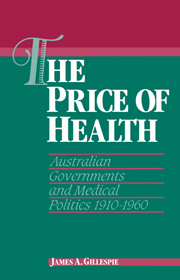Book contents
- Frontmatter
- Contents
- List of Tables
- Preface
- Acknowledgements
- Abbreviations
- Part I Medicine and the State: 1900 to 1939
- Chapter 1 ‘A Game of Animal Grab’: Medical Practice, 1920–1939
- Chapter 2 National Hygiene and Nationalization: the Failure of a Federal Health Policy, 1918–1939
- Chapter 3 Doctors, the States and Interwar Medical Politics
- Chapter 4 The Defeat of National Health Insurance
- Part II The Reconstruction of Medicine? Planning and Politics, 1940 to 1949
- Part III The Public and the Private
- Notes
- Bibliography
- Index
Chapter 3 - Doctors, the States and Interwar Medical Politics
Published online by Cambridge University Press: 22 September 2009
- Frontmatter
- Contents
- List of Tables
- Preface
- Acknowledgements
- Abbreviations
- Part I Medicine and the State: 1900 to 1939
- Chapter 1 ‘A Game of Animal Grab’: Medical Practice, 1920–1939
- Chapter 2 National Hygiene and Nationalization: the Failure of a Federal Health Policy, 1918–1939
- Chapter 3 Doctors, the States and Interwar Medical Politics
- Chapter 4 The Defeat of National Health Insurance
- Part II The Reconstruction of Medicine? Planning and Politics, 1940 to 1949
- Part III The Public and the Private
- Notes
- Bibliography
- Index
Summary
The programme of national hygiene fell victim to the absence of federal constitutional powers over health and the financial constraints – and lack of political will – of Commonwealth governments. While the primary level of health policy-making lay at state level, the Commonwealth could do little more than exhort or provide the inducements of tied funding to persuade the states to expand their public health activities. Responsibility for the support of university medical schools, medical registration, and, above all, the public hospitals lay in the hands of the state governments and each of the states experienced disputes over hospital finance, access to free beds in public wards and intervention to provide medical services in remote districts. The co-ordination of public and private medicine – the integration of curative and preventive services which lay at the heart of Cumpston's vision – remained elusive as long as his department had no mandatory powers.
This fragmented institutional structure helped to stunt the development of a national framework of health politics. The prime focus of organized medicine remained on the state governments, which were responsible for the regulatory structure which governed the hospital systems, professional licensure and the friendly societies. Hence, although each state faced similar problems of financing its hospitals and political pressures to enable access to adequate health care, institutional and political differences ensured that conflicts often took radically different forms, and were resolved by opposing methods.
- Type
- Chapter
- Information
- The Price of HealthAustralian Governments and Medical Politics 1910–1960, pp. 57 - 86Publisher: Cambridge University PressPrint publication year: 1991



